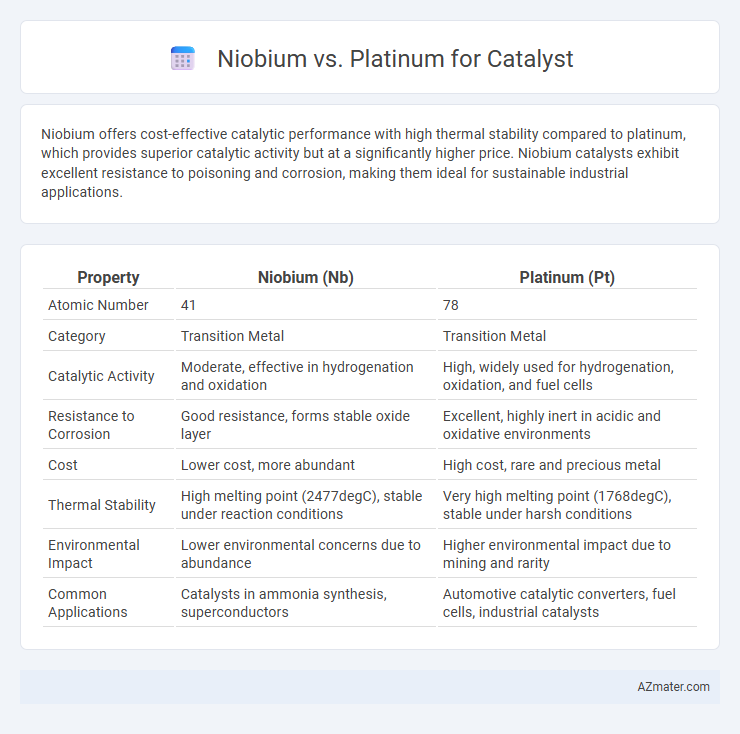Niobium offers cost-effective catalytic performance with high thermal stability compared to platinum, which provides superior catalytic activity but at a significantly higher price. Niobium catalysts exhibit excellent resistance to poisoning and corrosion, making them ideal for sustainable industrial applications.
Table of Comparison
| Property | Niobium (Nb) | Platinum (Pt) |
|---|---|---|
| Atomic Number | 41 | 78 |
| Category | Transition Metal | Transition Metal |
| Catalytic Activity | Moderate, effective in hydrogenation and oxidation | High, widely used for hydrogenation, oxidation, and fuel cells |
| Resistance to Corrosion | Good resistance, forms stable oxide layer | Excellent, highly inert in acidic and oxidative environments |
| Cost | Lower cost, more abundant | High cost, rare and precious metal |
| Thermal Stability | High melting point (2477degC), stable under reaction conditions | Very high melting point (1768degC), stable under harsh conditions |
| Environmental Impact | Lower environmental concerns due to abundance | Higher environmental impact due to mining and rarity |
| Common Applications | Catalysts in ammonia synthesis, superconductors | Automotive catalytic converters, fuel cells, industrial catalysts |
Introduction to Catalyst Materials: Niobium and Platinum
Niobium and platinum serve distinct roles as catalyst materials, with platinum widely recognized for its exceptional catalytic activity and stability in chemical reactions such as hydrogenation and fuel cells. Niobium offers unique advantages including high corrosion resistance and the ability to form stable oxides that enhance catalytic performance in selective oxidation and environmental applications. Comparing their electrochemical properties and cost-effectiveness highlights niobium's potential as a cost-efficient alternative to platinum in sustainable catalyst development.
Chemical Properties of Niobium vs Platinum
Niobium exhibits strong resistance to corrosion and high melting point (2477degC), making it stable under extreme catalytic conditions, whereas platinum has a lower melting point (1768degC) but exceptional catalytic activity due to its ability to adsorb and activate hydrogen and oxygen molecules. Chemically, niobium forms stable oxides (Nb2O5) that can influence catalytic selectivity and durability, while platinum's surface facilitates efficient electron transfer and hydrogenation reactions. The electronic structure of platinum allows for superior catalytic performance in fuel cells and hydrogenation, but niobium's chemical robustness offers advantages in harsh reaction environments.
Catalytic Efficiency Comparison
Niobium exhibits promising catalytic efficiency due to its high surface area and strong electron-donating properties, enhancing reaction rates in heterogeneous catalysis. Platinum remains the benchmark catalyst with superior activity and stability across a wide range of reactions, including hydrogenation and oxidation, but its high cost limits large-scale applications. Comparative studies show niobium-based catalysts offering competitive performance in specific processes such as ammonia synthesis and selective oxidation, making them a cost-effective alternative to platinum in targeted catalytic applications.
Cost Analysis: Niobium vs Platinum
Niobium offers a significantly lower cost compared to platinum, making it a more economically viable option for catalyst applications. Platinum prices fluctuate around $30,000 per kilogram due to its rarity and high demand in catalytic converters, whereas niobium costs approximately $40 per kilogram, benefiting from greater abundance and lower extraction expenses. This substantial price difference positions niobium as a cost-effective alternative without compromising catalytic performance in many industrial processes.
Availability and Sustainability Concerns
Niobium offers greater availability as an abundant element primarily sourced from Brazil and Canada, whereas platinum is a rare and expensive metal with limited global reserves. Niobium's lower environmental impact during extraction and processing enhances its sustainability profile compared to platinum, which often involves energy-intensive mining and significant ecological disruption. These factors make niobium a more sustainable and scalable option for catalyst applications in industrial processes.
Applications in Chemical Reactions
Niobium catalysts excel in selective oxidation and hydrogenation reactions, offering high thermal stability and resistance to coking, which enhances durability in industrial chemical processes like ammonia synthesis and olefin metathesis. Platinum catalysts demonstrate superior activity and selectivity in hydrogenation, dehydrogenation, and fuel cell reactions, with widespread applications in automotive catalytic converters and fine chemical production. Both metals serve crucial roles in catalytic converters, but niobium's cost-effectiveness and resistance to sulfur poisoning make it increasingly attractive for large-scale applications.
Durability and Stability in Catalytic Processes
Niobium-based catalysts exhibit superior durability and stability in catalytic processes due to their high resistance to corrosion and thermal degradation, maintaining activity under harsh conditions. Platinum catalysts, while highly active, often suffer from sintering and poisoning, which reduce their lifespan and effectiveness over time. The robust chemical stability of niobium compounds makes them a cost-effective alternative to platinum in long-term catalytic applications.
Environmental Impact of Niobium and Platinum Catalysts
Niobium catalysts exhibit a lower environmental impact due to their abundance and lower toxicity compared to platinum, which relies on scarce and energy-intensive mining processes. Platinum catalysts, while highly efficient, contribute to significant environmental degradation through mining pollution and high energy consumption. The use of niobium reduces reliance on critical raw materials and supports more sustainable catalytic applications with reduced carbon footprint.
Recent Advances in Catalyst Technology
Recent advances in catalyst technology highlight niobium's growing role as a cost-effective and efficient alternative to platinum in catalytic applications, particularly in hydrogen evolution and oxygen reduction reactions. Niobium-based catalysts exhibit enhanced stability and catalytic activity due to their unique electronic structure and resistance to poisoning, offering promising performance in fuel cells and electrolyzers. Innovations in niobium nanostructuring and alloying techniques further improve catalytic efficiency, positioning niobium as a competitive material against platinum in sustainable energy technologies.
Future Prospects: Niobium Replacing Platinum?
Niobium's future as a catalyst contender is promising due to its lower cost, abundant availability, and excellent chemical stability compared to platinum. Research indicates niobium-based catalysts exhibit high activity and durability in reactions such as hydrogen evolution and oxygen reduction, which are critical in fuel cells and industrial processes. While platinum remains highly efficient, ongoing advancements in niobium nanostructures and alloy catalysts suggest a realistic potential for niobium to partially replace platinum in sustainable, large-scale catalytic applications.

Infographic: Niobium vs Platinum for Catalyst
 azmater.com
azmater.com